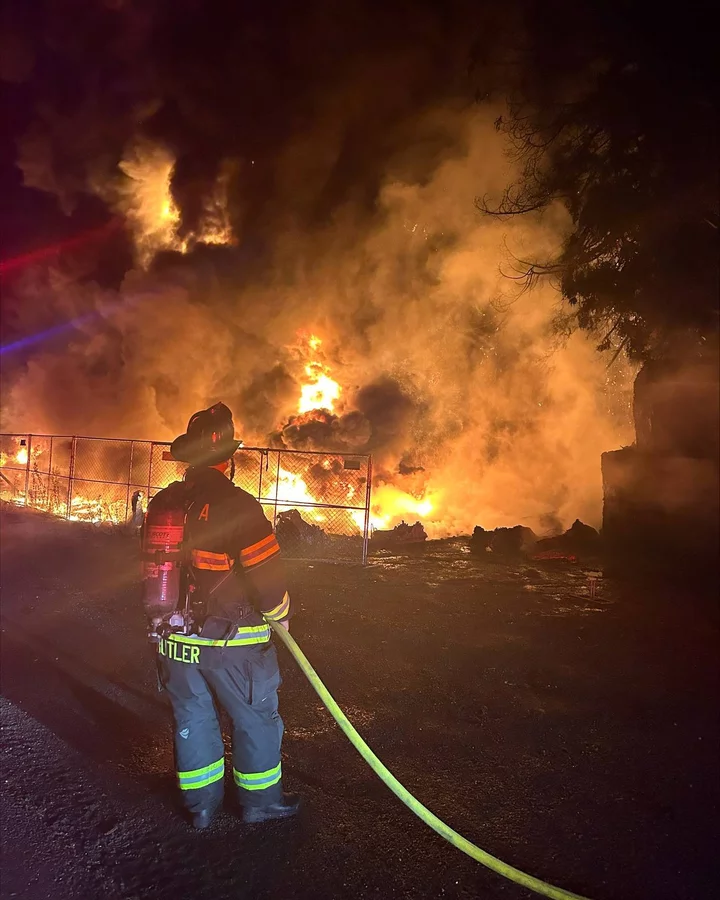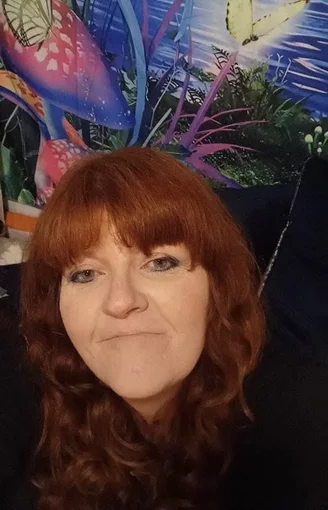YEE-HAW! Cal Poly Humboldt and CR Launch Men’s and Women’s Competitive Rodeo Program
LoCO Staff / Tuesday, July 2, 2024 @ 11:08 a.m. / Education
LoCO’s suggestion for a celebratory temporary addition to Cal Poly Humboldt’s main gate
Cal Poly Humboldt press release:
Cal Poly Humboldt and College of the Redwoods are excited to announce the launch of a new men’s and women’s rodeo program, set to launch in Fall 2024. This innovative collaboration will provide students exceptional opportunities to engage in rodeo activities while pursuing their degree at both institutions.
CR’s rodeo program will begin as a club sport with plans to transition to a full intercollegiate athletic team. The rodeo program at Cal Poly Humboldt will launch as a competitive sports club. In preparation for the program’s debuts, both CR and Cal Poly Humboldt plan to search for rodeo coaches and leaders. These coaches will play a pivotal role in training and mentoring student-athletes, as well as overseeing the overall management of the program.
The rodeo programs will benefit from a strategic partnership with Ferndale Fairgrounds, where both teams will practice and call home. These collaborations will provide students with access to top-notch facilities and resources, enriching their training and competitive experiences, while the pathway for students from CR to Humboldt will be seamless. This collaboration will also deepen the partnership between both institutions and the community, while offering significant advantages to local student-athletes. To ensure the financial sustainability of both the men’s and women’s programs, a fundraising initiative has begun and will be expanded.
This rodeo program underscores the broader commitment by CR and Cal Poly Humboldt to expand academic and extracurricular offerings and to provide diverse opportunities to students.
Cal Poly Humboldt President Tom Jackson, Jr. says, “Since 2019, our two institutions have been strategizing about the implementation of a rodeo program that provides a home for our local students to compete in a championship environment. That time has come, and we are excited about the future of collegiate rodeo in Humboldt County.”
College of the Redwoods President Keith Flamer is very excited to partner with Cal Poly Humboldt to bring collegiate rodeo to the area:“I am very proud of our partnership with Cal Poly Humboldt to create these rodeo programs. This collaboration offers a wonderful opportunity to elevate college rodeo in our area and create new pathways for student-athletes to pursue their academic and rodeo dreams.”
BOOKED
Yesterday: 9 felonies, 6 misdemeanors, 0 infractions
JUDGED
Humboldt County Superior Court Calendar: Today
CHP REPORTS
No current incidents
ELSEWHERE
RHBB: West Coast Health Alliance Recommends American Academy of Pediatrics Vaccine Schedule
RHBB: Pedestrian Struck by Vehicle in Redway
Governor’s Office: Governor Newsom’s statement on Valero’s Benicia refinery update
Governor’s Office: Governor Newsom announces appointments 1.6.2026
Crews Extinguish Large Vegetation Fire East of Arcata
LoCO Staff / Tuesday, July 2, 2024 @ 9:40 a.m. / Fire
AFD
Arcata Fire District release:
On Tuesday, July 2 at 1:38 A.M., the Arcata Fire District was dispatched to a commercial vehicle fire on HWY 299 at exit 3A.
The first arriving unit stated that it was not a vehicle on fire, but foam blocks covered in plastic on the side of the highway were heavily involved. The initial response only dispatched two engines and a duty officer, however additional resources were ordered immediately. Two water tenders were dispatched from Blue Lake Volunteer Fire and Fieldbrook Volunteer Fire as well as four additional engines from Humboldt Bay Fire, CalFire Trinidad, Westhaven Volunteer Fire and Kneeland Volunteer Fire as it appeared that the fire was spreading to nearby vegetation.
Arcata police was initially on scene, but called in units from Caltrans to assist with traffic control.
The fire was fought to the point that Kneeland’s engine was released to cover the Arcata station, and Westhaven’s engine was released to cover the Mad River station. Both cover engines ran medical calls and one small 5x5 fire call during their coverage of Arcata Fire’s stations.
Arcata Fire would like to extend our gratitude towards our mutual aid partners Humboldt Bay Fire, Blue Lake Volunteer Fire, Fieldbrook Volunteer Fire, Westhaven Volunteer Fire, CalFire Trinidad, Kneeland Volunteer Fire, Arcata Police and Caltrans.
The cause of the fire is currently unknown. This is a reminder to the community that with the rising temperatures and dried grasses, fire season is upon us. Use extreme caution this weekend if and when you choose to use fireworks, barbecues or bonfires, and always have a way to extinguish any small fires that may occur like an extinguisher or hose nearby.
Does a Proposed $10 Billion Bond Favor Richer California School Districts?
Carolyn Jones / Tuesday, July 2, 2024 @ 7:35 a.m. / Sacramento
A new classroom at Burnt Ranch Elementary School in Trinity County on Dec. 13, 2019. Photo by Dave Woody for CalMatters
As lawmakers finalize a school facilities bond for the November ballot, some superintendents from low-income and small districts say the proposal leaves them with an all-too-familiar feeling: underfunded and overlooked.
“Am I mad? Yeah, I am very mad,” said Gudiel Crosthwaite, superintendent of Lynwood Unified, in a low-income area in Los Angeles County. “California has a responsibility to educate its children, regardless of where they live. This bond favors larger, higher-wealth districts at the expense of districts like ours.”
Lawmakers struck a deal late Saturday night on Assembly Bill 247, a $10 billion bond that would pay for repairs and upgrades at K-12 schools and community colleges throughout the state. Schools desperately need the money: The current fund for school repairs is nearly empty and the voters rejected the state’s last school facilities bond, in 2020.
Everyone agrees on the need for money to fix dry rot and build new science labs. But some superintendents, as well as the civil rights law firm Public Advocates, had been pushing for a more equitable way to distribute the money. Currently, the state doles out facilities funding through 50-50 matching grants, which means that districts that can raise a lot of money locally — typically, higher-income areas — can get more state money.
Public Advocates has threatened to sue California if it doesn’t adopt a wider sliding scale for distributing the money. The current deal does include a sliding scale, but it’s only from 60% to 65%, not the 5% to 90% that Public Advocates wanted. Under the deal’s scale, the state’s wealthiest districts would only get slightly less than its poorest.
Also under the current proposal, schools could get more money if they hire union contractors for their construction projects. That gives an edge to urban areas where union labor is easier to find.
“California has a responsibility to educate its children, regardless of where they live. This bond favors larger, higher-wealth districts at the expense of districts like ours.”
— Gudiel Crosthwaite, superintendent, Lynwood Unified Dchool District
Brooke Patton, spokeswoman for the State Building and Trades Council of California, said hiring union workers would benefit any school project because the workers are highly trained and efficient. Union projects also include apprentices, who may be from the local community.
“Not only does California end up with new school facilities, but also a new generation of workers who can afford to live in California and contribute to our economy for years to come — a worthy investment of public funds,” Patton said.
The bill still needs to pass both houses with a two-thirds majority and be signed by the governor this week. To go into effect, it needs approval from a simple majority of voters in the fall.
‘It’s a compromise’
While the bill doesn’t satisfy every need for California’s schools, it’s better than nothing, some education advocates said this week.
“It’s not perfect; it’s a compromise,” said Derick Lennox, senior director at California County Superintendents, which represents school administrators and is supporting the bill. “(The bond) takes incremental, important steps toward equity that will do a lot of good.”
The bill includes some help for smaller and low-income districts, such as providing extra money to hire project managers and expanding the number of districts that qualify for hardship funds. It also sets aside 10% of the money for small districts.
The California School Boards Association is also supporting the bill, along with a companion bill, AB 2831, sponsored by Assemblymember Josh Hoover, a Republican from Folsom, that would provide more relief for small and low-income districts if the school bond passes in November.
“We’re more than sympathetic to the needs of small districts,” said association spokesperson Troy Flint. “But times are tight, and we feel it’s crucial to get a school bond on the ballot. … It’s not what we need, but it’s what we could get. Now we have to focus on getting it passed, for the health and safety of California students.”
Old heaters, outdated kitchens, no AC
Trinity County Superintendent Fabio Robles said that some of the schools in his county are so dilapidated that any money is welcome. Passing local bonds is almost impossible, he said, because the county is so poor. So schools are almost totally reliant on the state for repairs.
In Lewiston, the gym has no air conditioning and the kitchen dates from the 1950s, Robles said. At Van Duzen Elementary, a small K-8 school in the mountains, the heater is 40 years old.
“Would a 5-90% sliding scale have been better? Yes. But what’s being proposed now will be a big help to us,” Robles said. “I’ll take that any day of the week.”
In Lynwood, Superintendent Crosthwaite said he’s tired of low-income students having to put up with broken air conditioners and leaky roofs while their more affluent peers enjoy state-of-the-art facilities. His district, for example, is going to ask voters this fall to approve a bond for $80 million. Across town, Pasadena Unified is moving forward with a $900 million school facilities bond. If the state offers matching grants, Pasadena will get even more money.
“We’re more than sympathetic to the needs of small districts. But times are tight, and we feel it’s crucial to get a school bond on the ballot.”
— Troy Flint, spokesperson, California School Boards Association
Meanwhile, students in Lynwood Unified lack basic facilities, he said. A middle school only has a blacktop, no green space. An elementary school lacks hot water. The district doesn’t have enough performance spaces or science labs.
“Our kids think this is normal. It should not be ‘normal,’” Crosthwaite said. “In California we call ourselves progressive, but we need to take a hard look at how we allocate our resources.”
###
CalMatters.org is a nonprofit, nonpartisan media venture explaining California policies and politics.
OBITUARY: Patricia Joan Hassler, 1935-2024
LoCO Staff / Tuesday, July 2, 2024 @ 6:56 a.m. / Obits
Patricia Joan Hassler (Kitchen) passed away peacefully June 22, 2024, in Arcata, surrounded by her loving family.
Pat was born March 14, 1935, to Wesley and Florence Kitchen in McCook, Nebraska. Born the eldest of three children, Pat grew up in a loving family with many relatives living close by to guide her. As a young girl, Pat was a happy blend of princess and tomboy enjoying fishing and boating with her dad and helping her mom in the kitchen. She was an attentive older sister and treasured the company of her two siblings. Pat graduated from McCook High School in 1952, where she was active in athletics, both basketball and baseball. She was a member of the Student Council and the Pep Club, a cheerleader for the athletic teams and disc jockeyed a teen program for a local radio station. Patricia asked a young Tom Hassler to attend the Sadie Hawkins Day dance in their junior year and thus began a lifelong romance.
Pat was awarded scholarships and worked summers as a clerk at Clapp’s Store and the McCook Packing Corporation to help fund her education. Pat went on to attend McCook Community College where she earned an AA Degree and later attended the University of Nebraska at Lincoln graduating with a Bachelor of Fine Arts in Education in 1956. She was a proud member of her college sorority, Alpha Phi, and served as chairperson of the scholarship committee.
Patricia married Thomas Joseph Hassler on December 27, 1956, in McCook, Nebraska and she began her teaching career at Beatrice Junior High School as an Art teacher. They moved to Logan Utah in 1957 where Tom continued his graduate work and Pat became mother to their four children: Jed, Michael, Wesley, and Tracy. She would often quip that she remembered little of those years as she was so busy chasing after all of them.
In 1963, the family moved to Pierre, South Dakota and Pat taught for the Bureau of Indian Affairs School. She held various positions in local community groups: Vice President of the local chapter for the American Association of University Women, President of the local Lutheran Women’s Missionary League and was a Den Mother for the Cub Scouts.
In late 1972, the family moved to Bayside, California where they enjoyed living in the redwoods and exploring the coast. Pat was an active member of the Lutheran Church of Arcata where she sang in the choir and led Bible Study groups. She was a Girl Scout Leader, a PEO member. Pat enjoyed the close friendship of many dear friends who regularly got together to play bridge, enjoy the culinary surprises of a progressive dinner club and attended various community events. Pat was an enthusiastic supporter of all her children’s athletic pursuits and could be found at their many games cheering them on.
In 1979, Pat began a 17-year career working for the McKinleyville Union School District at Morris Elementary School, working as a teacher’s aide and substitute. Pat returned to school and got a California Teaching Credential from Humboldt State University and taught second grade another seven years before retiring in 1996.
Upon retirement, Pat and Tom enjoyed travelling throughout the United States and Alaska, Canada, and Europe. Together they enjoyed local birdwatching, agate hunting and spending time with family and friends. Pat was a woman of strong Christian faith and a devoted wife and mother. She always marveled at the growth of her wonderful family and was proud of each one. She has left behind a legacy of love that will sustain us all.
Patricia was preceded in death by her husband Thomas Joseph Hassler, her parents, Wesley Byrn and Florence Anna Kitchen and a brother, Robert Wesley Kitchen. Pat is survived by her sister JoAnn “Jody” (Kitchen) Bamesberger and husband Mark of Aurora, Colorado, and her children: Jed Thomas Hassler and wife Jeannette of Arcata, Michael Byrn Hassler and wife Pamela of Reno, Nevada, Wesley Joseph Hassler and wife Mariann of Fieldbrook, and Tracy Ann Hassler-Jacobsen and husband Jeffrey of Mesa, Arizona. Pat is also survived by her 10 grandchildren and 22 great grandchildren.
A small celebration of life will be held at a future date.
###
The obituary above was submitted on behalf of Patricia Hassler’s loved ones. The Lost Coast Outpost runs obituaries of Humboldt County residents at no charge. See guidelines here.
OBITUARY: Dakota Rose Stafslien, 1996-2024
LoCO Staff / Tuesday, July 2, 2024 @ 6:56 a.m. / Obits
With much sadness, Dakota Rose Stafslien unexpectedly passed away at the young age of 28 in the early hours of May 4, 2024. She was born March 19, 1996 in Garberville, but grew up in Shelter Cove. Dakota attended Whale Gulch School, Redway Elementary and South Fork High School.
Dakota had many passions. She was certified in massage and over the past year she attended many classes at College of the Redwoods, including Fire Academy, which she had just graduated and was getting ready to start a career in with friends she made along the way. Dakota recently took a trip sailing to the Bahamas with friends she met online and told us all about the pigs that live on the beaches there. It was a great adventure !
Dakota loved art! All art! She always kept herself busy with a range of hobbies that included art (of course), music, beading, sewing, kayaking, road trips and learning all she could from making kombucha to documentaries that she would put online. Dakota’s ray of sunshine will be sorely missed by everyone who loved her, including her best friend Weston Cole Field who was always there for her. They shared many adventures together, and Arianna Guillette, whom she grew up with, was always by her side.
She is survived by her mother, Sandra Brown (Ferndale); father, Samuel Stafslien (Shelter Cove); sister Jasmine (Torrey) Hass and their three children, Olivia, Oliver and Felix Hass (Garberville); and half-sister Sammy Stafslien (Whitethorn); grandfather Bruce Winter (Mountain View, Arkansas ); and second grandmother Kathy Brown (Fort Bragg).
Dakota is preceded in death on her mother’s side by her second father, Wade Brown (Miranda); and grandmother Kathy Winter (Mountain View, Arkansas); and second grandfather Whitey Brown (Fort Bragg). On her father’s side both grandparents Tim and Barbara Stafslien ( Southern Humboldt area).
I would also like to thank everyone who lent Dakota a helping hand over the years whenever she needed it.
###
The obituary above was submitted on behalf of Dakota Rose Stafslien’s loved ones. The Lost Coast Outpost runs obituaries of Humboldt County residents at no charge. See guidelines here.
OBITUARY: Gerald Drucker, 1952-2024
LoCO Staff / Tuesday, July 2, 2024 @ 6:56 a.m. / Obits
Gerald Drucker passed away peacefully at home under Hospice care
surrounded by his family on April 4, 2024. He was born May 26, 1952
in New York, N.Y. to Estelle (Stahl) and George Drucker and spent his
youth growing up and going to school in the New York area.
Jerry spent his childhood and teen summers on Ocean Beach, Fire Island where he formed enduring friendships with family and friends. He was a member of the lifeguard team and developed his love of and skill in surfing. After graduating from Fieldstone High School he followed his surfing dream to the Southern California coast and attended UC Irvine. He left college after a year and moved on to the beaches of Mexico to focus his studies on surfing. He returned to academics and graduated from Bard College in psychology before moving to Santa Barbara to continue his studies. During his time at UCSB he balanced his academics with more surfing and met his to-be spouse, Lynda McDevitt. He graduated in 1983 with a Ph.D in psychology and a minor in surfing.
Jerry moved to Regina, Sask., Canada to be employed at the Merici Center, an early childhood intervention center. There he and Lynda were married and shortly after had their first son, Michael. This was a time of professional growth, devotion to his new family, the development of long-time friends and, as any ocean was over a thousand miles away, an enthusiasm for cross-country skiing.
After four years in Canada the call of the Pacific Ocean and family led to a return to California. Jerry, Lynda and Michael made their home in Westhaven and in 1992 added their son, Jesse, to the family. There Jerry expanded his sports enthusiasm to include mountain biking, downhill skiing and backpacking. Through these activities he developed strong friendships and offered fabulous adventures to his family.
Jerry was employed at the Redwood Coast Regional Center, which provides services for clients with developmental disabilities and their families. Jerry stayed at the RCRC for 34 years. He also worked a day per week at Hoopa Valley Tribe, Division of Human Services for 17 years and also had a private practice in Eureka. In each of these settings he was known to provide caring advocacy and compassionate counsel to his many clients and established warm bonds with his colleagues in the centers he worked at.
Jerry suffered a series of strokes in 2019, which preceded the final stroke in March 2024. His capabilities as an excellent athlete and brilliant mind were diminished over these years but the playfulness, interest in sports, humor, and generosity were never diminished. He will be remembered as a warmhearted being who loved life to the fullest.
Jerry is survived by his wife of 40 years, Lynda McDevitt; his sons, Michael and Jesse Drucker, their respective partners, Ivonne Romero and Madeline Cooper; his nieces, Sarah Dowling, Jessica Houlder and Devon Marvel; his brothers-in-law and sister-in-law, Ray and Mary McDevitt and Ben Dowling; and numerous grand-nephews and nieces and cousins. He was preceded in death by his parents, Estelle and George Drucker; his sister, Lauri Dowling; and cousin Risa Krive.
A memorial will be held at the Unitarian Universalist Fellowship in Arcata on August 3 from 1-4 p.m.
###
The obituary above was submitted on behalf of Gerald Drucker’s loved ones. The Lost Coast Outpost runs obituaries of Humboldt County residents at no charge. See guidelines here.
OBITUARY: Antoinette ‘Toni’ Moody-Holland, 1972-2024
LoCO Staff / Tuesday, July 2, 2024 @ 6:56 a.m. / Obits
Antoinette “Toni” Moody-Holland
August 5, 1972 - April 3, 2024
Antoinette “Toni” Moody-Holland passed away unexpectedly on Wednesday April 3, 1972. Born on August 5, 1972 to Butch Moody and Joan Burke in Garberville.
In the early ‘90s she met Brian Anderson. Her and Brian welcomed their first and only child together, Allen, in 1994. Toni went on to meet her first husband, James Holland. James and Toni had their first child in 1997 — Katie. James, Toni and their kids lived in Fortuna for awhile before James’ job moved them to Scotia. Toni was a stay-at-home mom, while Katie was young. Toni loved to be involved with her kids’ classroom activities, going on field trips, volunteering for field day chaperone, and just getting to hang out with her kids.
In 2004, James and Toni separated, and Toni moved across the river to be closer to her job. While living in Rio Dell, Toni worked at E&J Liquors as the baker/deli manager. Her daughter Katie has fond memories of being the one to make the design with a fork on their peanut butter cookies while “working” alongside her.
In 2004, after her separation with James, she met Ryan Moon. Who she moved to Loleta with. In 2006, they welcomed a baby girl, Tasheena.
Toni loved her kids with so much of her being, having three beautiful children is something she would brag about to anyone she talked too. If you’ve ever had a conversation with Toni, it’s certain you heard about her kids.
Toni loved rocks, collecting trinkets, doing arts & crafts, writing poems, frogs; all the little things. Toni really just had a love for the important to her things in life.
Toni is preceded in death by her mom, Joan; her dad and step-mom, Butch and Jan Moody; and her sister Buffy.
Toni left behind her three children, Allen Holland, Katie Holland (Karl Delara) and Tasheena Moon; her basically adopted son Angel; her long time boyfriend Ryan Moon; her sisters Tina Moody (Byron Titus), Deena Yadon and Starla Moody; her two best friends Eva and Melene; and so many nieces and nephews; all of who knew how much they meant to her.
She loved her family more than anything and we will miss her for the rest of our lives.
###
The obituary above was submitted on behalf of Toni Moody-Holland loved ones. The Lost Coast Outpost runs obituaries of Humboldt County residents at no charge. See guidelines here.









